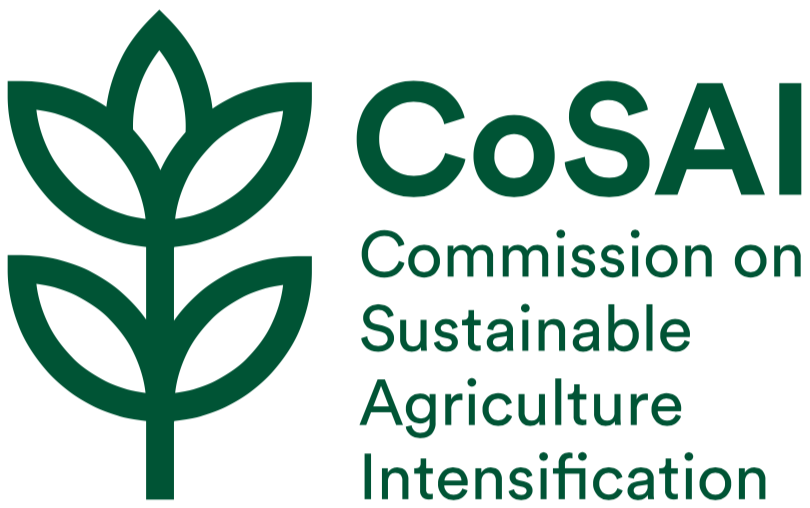Résultats de la recherche
Displaying 1 - 10 of 22 results.
Innovation in smallholder farming in Africa: recent advances and recommendations. Proceedings of the International Workshop on Agricultural Innovation Systems in Africa (AISA)
These proceedings include all the papers presented during the AISA workshop either as oral papers or as posters. It also includes the edited text resulting from the Living Keynote process, an innovation in itself.
The AISA workshop was held on 29-31 May 2013 in Nairobi, Kenya, as part of an international week devoted to Agricultural innovation in Africa. The AISA workshop focused on active social learning among participants, developed a collective "living keynote" about the following issues:
Sujet(s):
renforcement des capacités (RC)vulgarisationsystèmes d'exploitation agricoleinnovationapprentissagerecherchedéveloppement rural...
Année de publication:
2014Study on impacts of farmer-led research supported by civil society organizations
Based on eleven case studies from Africa, Asia, and Latin America, this report describes farmer-led research findings and their dissemination, and analyzes available evidence on the impact of farmer-led approaches to agricultural research and development on rural livelihoods, local capacity to innovate and adapt, and influence on governmental institutions of agricultural research and development.
Sujet(s):
Service de vulgarisationrenforcement des capacités (RC)changement climatiqueéducationsystèmes d'innovationapprentissageapproches participativesrechercherecherche participativerecherche et développement (R & D)Petits agriculteurs...
Année de publication:
2014Comparison of frameworks for studying grassroots innovation: Agricultural Innovation Systems (AIS) and Agricultural Knowledge and Innovation Systems (AKIS)
The history of agricultural research and development (R&D) has never been static. Its philosophies, concepts and principles continue to change and to impact on present-day practices. It is imperative to understand and draw lessons from the old and new perspectives, which inform agricultural R&D processes and policy formulation in developing countries. The interest of this paper is, therefore, to draw relevant lessons that can explain the dynamics,of the innovation systems at the grassroots in sub-Saharan Africa in particular.
Sujet(s):
renforcement des capacités (RC)systèmes d'innovationinnovationsystèmes de connaissances et d'informationpolitiquesrechercherecherche et développement (R & D)...
Année de publication:
2009Compilation of cases of joint experimentation from Ethiopia, Kenya, Tanzania and Uganda
The project “Strengthening Community Resilience to Change: Combining Local Innovative Capacity with Scientific Research” (CLIC–SR), supported by the Rockefeller Foundation, was completed on 31 August 2016. During the four years since 2012, the Prolinnova Country Platforms in Ethiopia, Kenya, Tanzania and Uganda made large strides in:
Sujet(s):
renforcement des capacités (RC)changement climatiquedocumentationÉcoles pratiques d'agriculture (FFS)Égalité entre les sexesinnovationapprentissageprocessus multipartiteschaînes de valeur...
Année de publication:
2016Reorienting funding for research and innovation is an urgent step to transform agri-food systems
Sujet(s):
Année de publication:
2021Mining the gaps: Using machine learning to map 1.2 million agri-food publications from the Global South
The evidence base on agri-food systems is growing exponentially. The CoSAI-commissioned study, Mining the Gaps, applied artificial intelligence to mine more than 1.2 million publications for data, creating a clearer picture of what research has been conducted on small-scale farming and post-production systems from 2000 to the present, and where evidence gaps exist.
Sujet(s):
Année de publication:
2021Better instruments and approaches are needed to transform agri-food systems research and innovation
A range of approaches and financial instruments have been used to stimulate and support innovation in agriculture and resolve interlocking constraints for uptake at scale. These include innovation platforms, results-based payments, value chain approaches, grants and prizes, incubators, participatory work with farmer networks, and many more.
Sujet(s):
Année de publication:
2021Learning from agri-food innovation pathways in Brazil, India and Kenya
Innovation for sustainable agricultural intensification (SAI) is challenging. Changing agricultural systems at scale normally means working with partners at different levels to make changes in policies and social institutions, along with technical practices. This study extracts lessons for practitioners and investors in innovation in SAI, based on concrete examples, to guide future investment.
Sujet(s):
Année de publication:
2022Eight research and innovation principles for sustainable and equitable agri-food systems
A huge increase in investment in innovation for agricultural systems is critical to meet the Sustainable Development Goals and Paris Climate Agreement. Most of this increase needs to come from reorienting existing funding for innovation. However, understanding whether an investment will fully promote environmentally sustainable and equitable agri-food systems can be difficult.
Sujet(s):
Année de publication:
2022Pages
Sorting block
Filtrer par idiome
Filtrer par sujet(s)
- advisory services (1) Apply advisory services filter advisory services
- capacity development (CD) (4) Apply capacity development (CD) filter capacity development (CD)
- climate change (3) Apply climate change filter climate change
- documentation (2) Apply documentation filter documentation
- education (2) Apply education filter education
- extension (2) Apply extension filter extension
- farming systems (1) Apply farming systems filter farming systems
- food and nutrition security (1) Apply food and nutrition security filter food and nutrition security
- gender equality (1) Apply gender equality filter gender equality
- innovation systems (17) Apply innovation systems filter innovation systems
- knowledge and information systems (4) Apply knowledge and information systems filter knowledge and information systems
- learning (6) Apply learning filter learning
- multi-stakeholder processes (2) Apply multi-stakeholder processes filter multi-stakeholder processes
- networks (1) Apply networks filter networks
- participatory approaches (2) Apply participatory approaches filter participatory approaches
- policies (4) Apply policies filter policies
- research (8) Apply research filter research
- rural development (1) Apply rural development filter rural development
- sustainable agriculture (6) Apply sustainable agriculture filter sustainable agriculture
- value chains (2) Apply value chains filter value chains
Filtrer par auteur(s)
- (-) Remove Commission on Sustainable Agriculture Intensification (CoSAI) filter Commission on Sustainable Agriculture Intensification (CoSAI)Commission on Sustainable Agriculture Intensification (CoSAI)
- Adekunle A. A. (9) Apply Adekunle A. A. filter Adekunle A. A.
- Africa Lead (8) Apply Africa Lead filter Africa Lead
- Agrinatura (31) Apply Agrinatura filter Agrinatura
- Asia-Pacific Association of Agricultural Research Institutions (APAARI) (9) Apply Asia-Pacific Association of Agricultural Research Institutions (APAARI) filter Asia-Pacific Association of Agricultural Research Institutions (APAARI)
- Asia-Pacific Islands Rural Advisory Services Network (APIRAS) (12) Apply Asia-Pacific Islands Rural Advisory Services Network (APIRAS) filter Asia-Pacific Islands Rural Advisory Services Network (APIRAS)
- CDAIS project (87) Apply CDAIS project filter CDAIS project
- Chowdhury A. (9) Apply Chowdhury A. filter Chowdhury A.
- Dhehibi B. (9) Apply Dhehibi B. filter Dhehibi B.
- Dijkman J. (8) Apply Dijkman J. filter Dijkman J.
- Dror I. (24) Apply Dror I. filter Dror I.
- Ekong J. (8) Apply Ekong J. filter Ekong J.
- Fatunbi O. (15) Apply Fatunbi O. filter Fatunbi O.
- Food and Agriculture Organization of the United Nations (FAO) (103) Apply Food and Agriculture Organization of the United Nations (FAO) filter Food and Agriculture Organization of the United Nations (FAO)
- Food and Agriculture Organization of the United Nations ( FAO ) (54) Apply Food and Agriculture Organization of the United Nations ( FAO ) filter Food and Agriculture Organization of the United Nations ( FAO )
- Grovermann C. (8) Apply Grovermann C. filter Grovermann C.
- Hall, A. (24) Apply Hall, A. filter Hall, A.
- Hall A. (10) Apply Hall A. filter Hall A.
- Hoekstra D. (11) Apply Hoekstra D. filter Hoekstra D.
- International Fund for Agricultural Development (15) Apply International Fund for Agricultural Development filter International Fund for Agricultural Development
- International Fund for Agricultural Development (IFAD) (12) Apply International Fund for Agricultural Development (IFAD) filter International Fund for Agricultural Development (IFAD)
- International Livestock Research Institute (10) Apply International Livestock Research Institute filter International Livestock Research Institute
- Klerkx, L. (25) Apply Klerkx, L. filter Klerkx, L.
- Klerkx L. (46) Apply Klerkx L. filter Klerkx L.
- Kumpf, B. (8) Apply Kumpf, B. filter Kumpf, B.
- Lamers D. (8) Apply Lamers D. filter Lamers D.
- Leeuwis, C. (15) Apply Leeuwis, C. filter Leeuwis, C.
- Leeuwis C. (15) Apply Leeuwis C. filter Leeuwis C.
- Lema Z. (7) Apply Lema Z. filter Lema Z.
- Lundy M. (11) Apply Lundy M. filter Lundy M.
- Makate C. (8) Apply Makate C. filter Makate C.
- Mango N. (8) Apply Mango N. filter Mango N.
- Najjar D. (8) Apply Najjar D. filter Najjar D.
- Nichterlein K. (9) Apply Nichterlein K. filter Nichterlein K.
- Ojijo N.K.O. (13) Apply Ojijo N.K.O. filter Ojijo N.K.O.
- Organisation for Economic Co-operation and Development (7) Apply Organisation for Economic Co-operation and Development filter Organisation for Economic Co-operation and Development
- Qaim M. (58) Apply Qaim M. filter Qaim M.
- Sartas M. (16) Apply Sartas M. filter Sartas M.
- Schut M. (44) Apply Schut M. filter Schut M.
- Schut, M. (10) Apply Schut, M. filter Schut, M.
- Sulaiman R. V. (11) Apply Sulaiman R. V. filter Sulaiman R. V.
- Sulaiman, R. V. (18) Apply Sulaiman, R. V. filter Sulaiman, R. V.
- TAP Secretariat (22) Apply TAP Secretariat filter TAP Secretariat
- The World Bank (11) Apply The World Bank filter The World Bank
- Tropical Agriculture Platform (TAP) (33) Apply Tropical Agriculture Platform (TAP) filter Tropical Agriculture Platform (TAP)
- Turner J.A. (8) Apply Turner J.A. filter Turner J.A.
- Wongtschowski, M. (9) Apply Wongtschowski, M. filter Wongtschowski, M.
- World Bank (61) Apply World Bank filter World Bank
- World Bank Group (17) Apply World Bank Group filter World Bank Group
- Zilberman D. (8) Apply Zilberman D. filter Zilberman D.
Filtrer par pays
- Kenya (4) Apply Kenya filter Kenya
- India (2) Apply India filter India
- Brasil (1) Apply Brasil filter Brasil
- Brazil (1) Apply Brazil filter Brazil
- Colombia (1) Apply Colombia filter Colombia
- Ethiopia (1) Apply Ethiopia filter Ethiopia
- Germany (1) Apply Germany filter Germany
- Nigeria (1) Apply Nigeria filter Nigeria
- Sri Lanka (1) Apply Sri Lanka filter Sri Lanka
- Tanzania (1) Apply Tanzania filter Tanzania
- Uganda (1) Apply Uganda filter Uganda
Filtrer par éditeur(s)
- Commission on Sustainable Agriculture Intensification (17) Apply Commission on Sustainable Agriculture Intensification filter Commission on Sustainable Agriculture Intensification
- AISA Workshop on Agricultural Innovation Systems in Africa (1) Apply AISA Workshop on Agricultural Innovation Systems in Africa filter AISA Workshop on Agricultural Innovation Systems in Africa
- Foreign, Commonwealth & Development Office (1) Apply Foreign, Commonwealth & Development Office filter Foreign, Commonwealth & Development Office
- GFAiR - The Global Forum on Agricultural Research and Innovation (1) Apply GFAiR - The Global Forum on Agricultural Research and Innovation filter GFAiR - The Global Forum on Agricultural Research and Innovation
- International Food Policy Research Institute (1) Apply International Food Policy Research Institute filter International Food Policy Research Institute
- PROLINNOVA (1) Apply PROLINNOVA filter PROLINNOVA
- WorldFish (1) Apply WorldFish filter WorldFish




